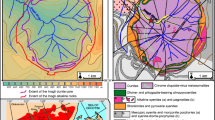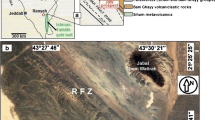Abstract
The Bogosu-Prestea mining district of southwestern Ghana is a 33 km section of the Early Proterozoic Ashanti Gold Belt. Greenschist facies carbonaceous and carbonate-bearing turbidites and greywackes, and mafic dikes host numerous economic mesothermal gold deposits. Structurally higher ores in the Bogosu concession have brittle deformation and consist of disseminated-sulphide lodes in tectonically-disrupted sedimentary rocks and carbonate-altered mafic dikes. Most gold occurs as micrometre-size particles in arsenian pyrite, and as “invisible” gold in arsenian pyrite and arsenopyrite. The structurally deeper ores of the adjoining Prestea concession are associated with brittle-ductile deformation and consist of extensive crack-seal quartz-veins and graphitic shear zones. Only minor amounts of “invisible” gold were detected; in these deeper lodes, gold occurs dominantly as abundant microscopic and larger particles in sulphide/arsenide minerals and in gangue. The gold distribution patterns revealed by SIMS microprobe analysis and ion maps, EMP and colour staining suggest that most of the primary gold in the Bogosu-Prestea system precipitated in solid-solution with sulphide/arsenide minerals. However, post-depositional concentration and redistribution occurred, in increasing degree with: 1) increase in metamorphic/hydrothermal gradients in the gold system (depth), 2) decrease in the refractory properties of the host mineral, and 3) increase in the amount of post-depositional, host-mineral recrystallization and deformation. Gold evolved from primary solid-solution within sulphide/arsenide minerals, to colloidal and micrometre-size particles concentrated in voids, fractures and internal grain boundaries, and finally to microscopic and larger particles at sulphide/arsenide grain margins and in the gangue assemblage. The general conclusions presented here are applicable to As-rich gold deposits of all ages, worldwide. The presence of gold in late fractures is insufficient evidence for late-stage introduction of gold in mesothermal gold systems.
Similar content being viewed by others
References
Abouchami, W., Boher, M., Michard, A., Albarede, F. (1990) A major 2.1 Ga event of mafic magmatism in West Africa: An early stage of crustal accretion. J. Geophysical Res. 95:17,605–17,629
Adjimah, C.L. (1988) Petrological studies on the genesis of the gold deposits of Prestea, Ghana. Unpublished Thesis, Bundesanstalt fur Geowissenschaften und Rohstoffe, Hannover, 274 pp
Appiah, H., Norman, D.I. Boadi, I. (1991) The geology of the Prestea and Ashanti goldfields: a comparative study. In: Ladeira, E.A. (ed.) Brazil Gold 91. The economics, geology, geochemistry and genesis of gold deposits, pp. 247–255
Arehart, G.B., Chryssoulis, S.L., Kesler, S.E. (1993) Gold and arsenic in iron sulfides from sediment-hosted disseminated gold deposits: implications for depositional processes. Econ. Geol. 88:171–185
Bakken, B.M., Hochella, M.F., Jr., Marshall, A.F., Turner, A.M. (1989) High Resolution microscopy of gold in unoxidized ore from the Carlin mine, Nevada. Econ. Geol. 84:171–179
Barnes, H.L. (1979) Solubilities of ore minerals. In: Barnes, H.L. (ed.) Geochemistry of hydrothermal ore deposits 2nd edn. Wiley, New York, pp. 404–508
Bonnemaison, M. Marcoux, E. (1990) Auriferous mineralization in some shear-zones: a three-stage model of metallogenesis. Mineral Deposita 25:96–104
Cabri, L.J., Chryssoulis, S.L., De Villiers, J.P.R., Laflamme, J.H.G. Buseck, P.R. (1989) The nature of “invisible” gold in arsenopyrite. Can. Mineralogist 27:353–362
Cathelineau, M., Boiron, M.C., Hollinger, P. Marion, P., Denis, M. (1989) Gold in arsenopyrites: crystal chemistry, location and state, physical and chemical conditions of deposition. Econ. Geol. Monogr. 6:328–341
Chryssoulis, S.L., Cabri, L.J. (1990) Significance of gold mineralogical balances in mineral processing. Trans. Inst. Min. Metall. 99:C1-C10
Cook, N.J., Chryssoulis, L. (1990) Concentrations of ““invisible” gold” in the common sulfides. Can. Mineralogist 28:1–16
Drummond, S.E., Ohmoto, H. (1985) Chemical evolution and mineral deposition in boiling hydrothermal systems. Econ. Geol. 80:126–147
Ebel, D.S., Sack, R.O. (1989) Ag-Cu and As-Sb exchange energies in tetrahedrite-tennantite fahlores. Geochim. Cosmochim. Acta 53:2301–2309
Fleet, M.E., MacLean. P.J., Barbier, J. (1989) Oscillatory-zoned As bearing pyrite from strata-bound and stratiform gold deposits: An indicator of ore fluid evolution. Econ. Geol. Monogr. 6:356–362
Fleet, M.E., Chryssoulis, S.L., MacLean, P.J., Davidson, R., Weisener, C.G. (1993) Arsenian pyrite from gold deposits: Au and As distribution investigated by SIMS and EMP, and color staining surface oxidation by XPS and LIMS. Can. Mineralogist 31:1–17
Garard, T.F. (1989) Gold in Africa: jewellery and ornaments from Ghana, cote d'Ivoire, Mali and Senegal in the collection of the Barbier-Mueller Museum, Munich. Prestel, Munich New York, 247 pp
Goldfarb, R.J., Leach, D.L., Rose, S.C., Landis, G.P. (1989) Fluid inclusion geochemistry of gold-bearing quartz veins of the Juneau gold belt, southwestern Alaska. Econ. Geol. Monogr. 6:363–375
Goldfarb, R.J., Newberry, R.J., Pickthorn, W.J., Gent, C.A. (1991) Oxygen, hydrogen, and sulfur isotope studies in the Juneau Gold Belt, south-eastern Alaska: constraints on the origin of hydrothermal fluids. Econ. Geol. 86:66–80
Hackbarth, C.J., Petersen, U. (1984) Systematic compositional variations in argentian tetrahedrite. Econ. Geol. 79:448–460
Hastings, D.A. (1982) On the tectonics and metallogenesis of West Africa: a model incorporating new geophysical data. Geoexploration 20:295–327
Hayashi, K.-I., Ohmoto, H. (1991) Solubility of gold in NaCl and H2S-bearing aqueous solutions at 250–350°C. Geochim. Cosmochim. Acta 55:2111–2126
Haynes, S.J. (1986) Geology and chemistry of turbidite-hosted gold deposits, greenschist facies, eastern Nova Scotia. In: Keppie, J.D., Boyle, R.W., Haynes, S.J. (eds.) Turbidite-hosted gold deposits. GAC Special Paper 32:161–178
Jean, G.E., Bancroft, G.M. (1985) An XPS and SEM study of gold deposition at low temperatures on sulphide mineral surfaces: concentration of gold by adsorption/reduction. Geochim. Cosmochim. Acta 49:979–987
Junner, N.R. (1940) Geology of the Gold Coast and Western Togoland. Ghana Geol. Survey Bull. 11:40 pp
Kerrich, R., Wyman, D. (1990) Geodynamic setting of mesothermal gold deposits: an association with accretionary tectonic regimes. Geology 18:882–885.
Kesse, G.O. (1985) The mineral and rock resources of Ghana. Balkema, Rotterdam, 610 pp
Klemd, R., Hirdes, W., Olesch, M., Oberthur, T. (1993) Fluid inclusions in quartz-pebbles of the gold-bearing Tarkwaian conglomerates of Ghana as guides to their provenance area. Mineral. Deposita 28:334–343
Knipe, S.W., Foster, R.P. (1991) Hydrothermal precipitation of precious metals on sulfide substrates. In: Ladeira, E.A. (ed.) Brazil Gold 91. The economics, geology, geochemistry and genesis of gold deposits, pp 431–435
Knopf, D.J. (1988) Gold in West Africa and the Ivory Coast. Mining Magazine 158:392–396
Kontak, D.J., Smith, P.K. (1993) A metaturbidite-hosted lode gold deposit: the Beaver Dam deposit, Nova Scotia. 1. Vein paragenesis and mineral chemistry. Can. Mineralogist 31:471–522
Kretschmar, U., Scott, S.D. (1976) Phase relations involving arsenopyrite in the system Fe-As-S and their application. Can. Mineralogist 14:364–386
Leube, A., Hirdes, W., Mauer, R., Kesse, G.O. (1990) The early Proterozoic Birimian supergroup of Ghana and some aspects of its associated gold mineralization. Precambrian Res. 46:139–165
Marcoux, E., Bonnemaison, M., Braux, C, Johan, Z. (1989) Distribution de Au, Sb, As, et Fe dans l'arsenopyrite aurifere du Chatelet et de Villeranges (Creuse, Massif Central Francais). C. R. Acad. Sci. 308 II:293–300
Milesi, J.P., Ledru, P., Feybesse, J.L., Dommanget, A., Marcoux, E. (1992) Early Proterozoic ore deposits and tectonics of the Birimian erogenic belt, West Africa. Precambrian Res. 58:305–344
Mishra, B., Mookherjee, A. (1991) Tetrahedrite mineral chemistry and metal zoning: a thermodynamic assessment from the Rajpura-Dariba polymetallic deposit, India. Econ. Geol. 86:1529–1538
Mumin, A.H. (1994) Early Proterozoic Birimian gold mineralization of the Bogosu and Prestea districts of the Ashanti Gold Belt, Ghana, West Africa. Unpublished Ph.D. thesis, University of Western Ontario, London, Canada, 312 pp
Mumin, A.H., Fleet, M.E. (1994) Evolution of gold mineralization in the Ashanti Gold Belt, Ghana: evidence from carbonate compositions and paragenesis. Mineralogy Petrology (in press)
Mumin, A.H., Fleet, M.E., Longstaffe, F.J. (1994) Evolution of hydrothermal fluids in the Ashanti Gold Belt, Ghana: stable isotope geochemistry of carbonates, graphitic material and quartz. Econ. Geol. (submitted for publication)
Murowchick, J.B. (1990) Iron monosulfide precursors in low-temperature pyrite and marcasite formation (abstract). Geol. Soc. America 22:PA207
Murowchick, J.B. (1992) Marcasite inversion and the petrographic determination of pyrite ancestry. Econ. Geol. 87:1141–1152
Murowchick, J.B., Barnes, H.L. (1986) Marcasite precipitation from hydrothermal solutions. Geochim. Cosmochim. Acta 50:2615–2629
Naumov, G.B., Ryzhenko, B.N., Khodakovsky, I.L. (1974) Handbook of thermodynamic data. US Geol. Survey Report USGS-WRD-74-001, 328 pp
Romberger, S.B. (1989) Transport and deposition of precious metals in epithermal deposits. In: Romberger, S (ed.) Mechanisms of Gold transport and deposition in low temperature hydrothermal systems. National Centre for Management Research, University of Western Ontario, London, Ontario
Sack, R.O., Loucks, R.R. (1985) Thermodynamic properties of tetrahedrite-tennantites: constraints on the interdependence of the Ag-Cu, Fe-Zn. Cu-Fe, and As-Sb exchange reactions. Am. Mineralogisst 70:1270–1289
Sandiford, M., Keays, R.R. (1986) Structural and tectonic constraints on the origin of gold deposits in the Ballarat Slate Belt, Victoria. In: Keppie, J.D., Boyle, R.W. Haynes, S.J. (eds.) Turbidite-hosted Gold deposits. GAC Special Paper 32:15–24
Schoonen, M.A.A. Barnes, H.L. (1991a) Reactions forming pyrite and marcasite from solution. I. Nucleation of FeS2 below 100°C. Geochim. Cosmochim. Acta 55:1495–1504
Schoonen, M.A.A. Barnes, H.L. (1991b) Reactions forming pyrite and marcasite from solution. II. Via FeS precursors below 100°C. Geochim. Cosmochim. Acta 55:1505–1514
Sestini, G. (1973) Sedimentology of a paleoplacer: the gold-bearing Tarkwaian of Ghana. In: Amstutz, G.C. Bernard, A.J. (eds.) Sedimentary ores. Springer, Berlin Heidelberg New York, pp. 275–305
Seward, T.M. (1989) The hydrothermal chemistry of gold and its implications for ore formation: boiling and conductive cooling as examples. Econ. Geol. Monogr. 6:398–404
Seward, T.M., Barnes, H.L. (1989) Metal transport and deposition by hydrothermal ore fluids: an introduction. In: Barnes, H.L., Ohmoto, H. (eds.) Hydrothermal processes-application to ore genesis. Reidel Dordrecht
Sharp, Z.D., Essene, E.J. Kelly, W.C.(1985) A re-examination of the aresenopyrite geothermometer: pressure considerations and applications to natural assemblages. Can. Mineralogist 23:517–534
Shenberger, D.M. Barnes, H.L. (1989) Solubility of gold in aqueous sulfide solutions from 150 to 350°C. Geochim. Cosmochim. Acta 53:269–278
Starling, A., Gilligan, J.M., Carter, A.H.C., Foster, R.P. Saunders, R.A. (1989) High temperature hydrothermal precipitation of precious metals on the surface of pyrite. Nature 340:298–300
Taylor, P.N., Moorbath, S., Leube, A. Hirdes, W. (1992) Early Proterozoic crustal evolution in the Birimian of Ghana: constraints from geochronology and isotope geochemistry. Precambrain Res. 56:97–111
Wu, I. Petersen, U. (1977) Geochemistry of tetrahedrite and mineral zoning at casapalca, Peru. Econ. Geology 72:993–1016.
Author information
Authors and Affiliations
Rights and permissions
About this article
Cite this article
Mumin, A.H., Fleet, M.E. & Chryssoulis, S.L. Gold mineralization in As-rich mesothermal gold ores of the Bogosu-Prestea mining district of the Ashanti Gold Belt, Ghana: remobilization of “invisible” gold. Mineral. Deposita 29, 445–460 (1994). https://doi.org/10.1007/BF00193506
Received:
Accepted:
Issue Date:
DOI: https://doi.org/10.1007/BF00193506




